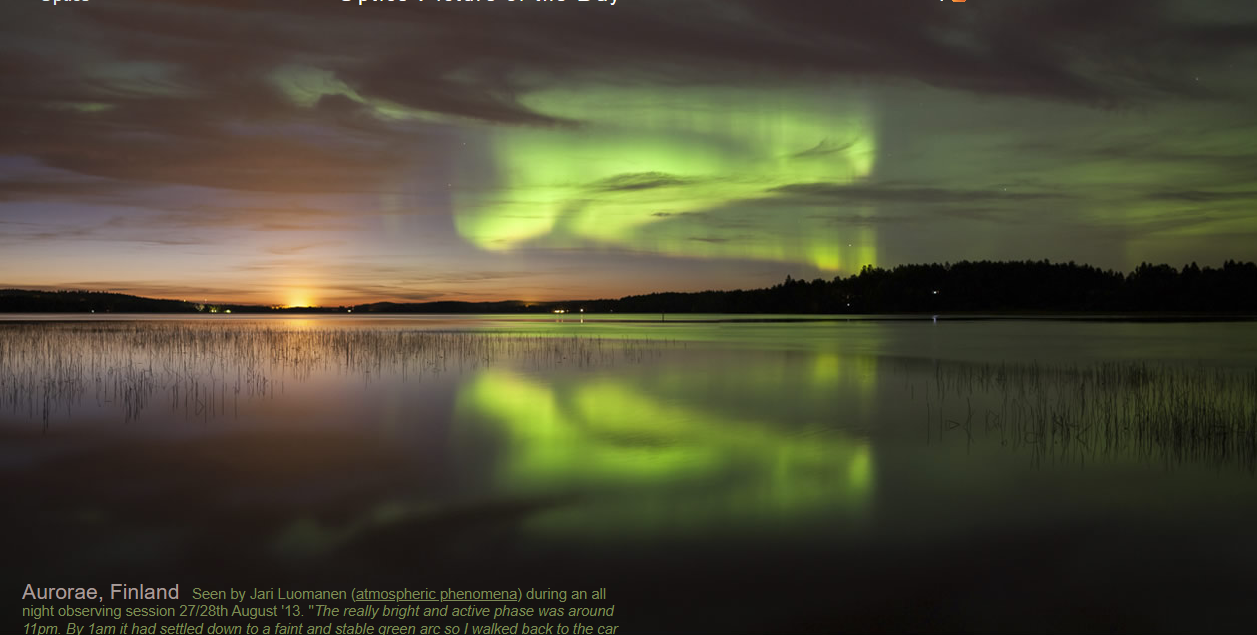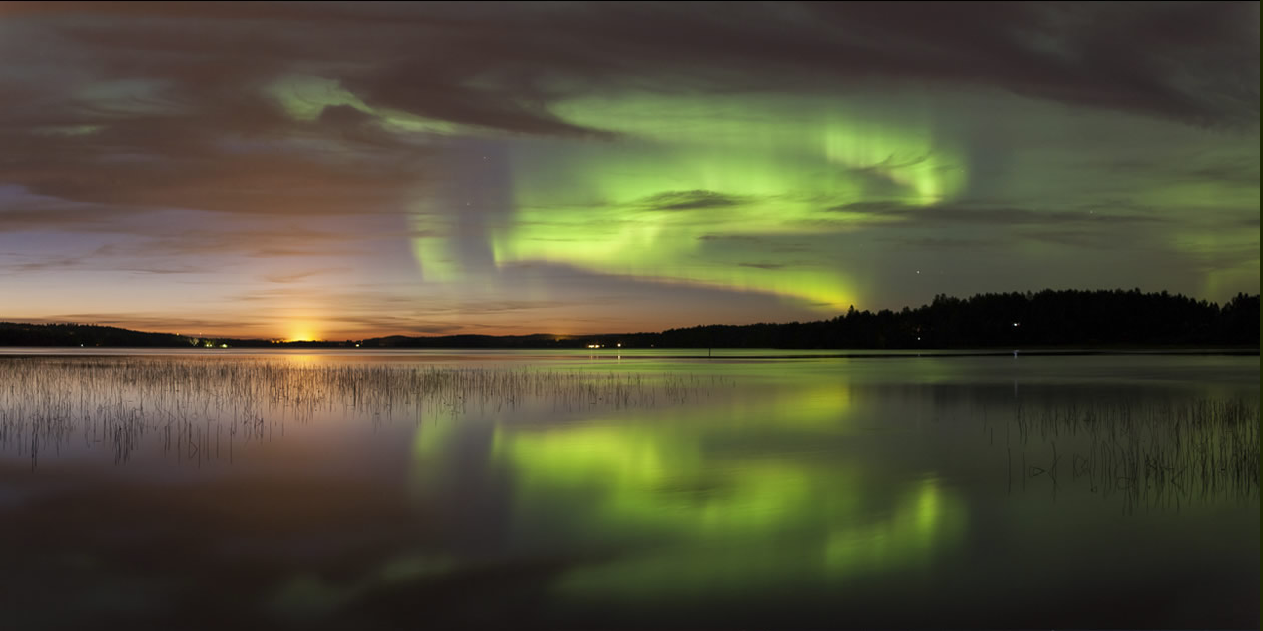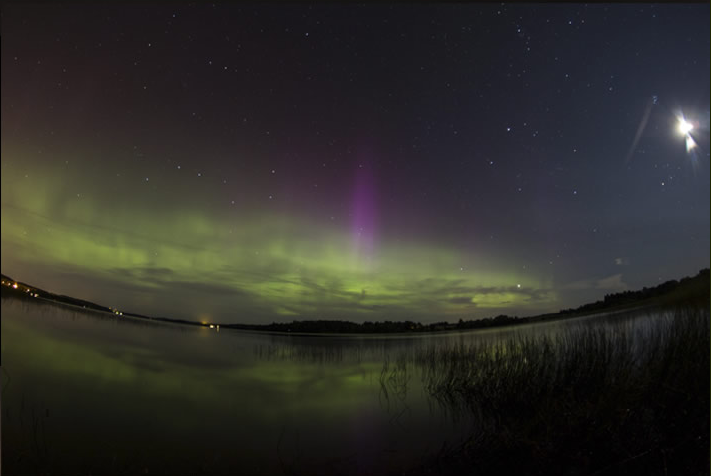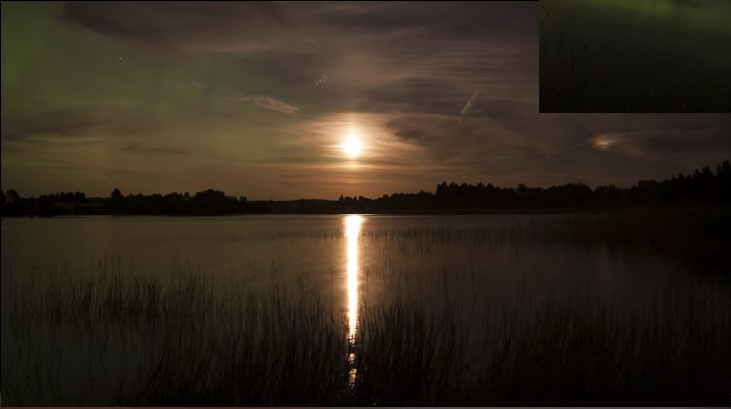Aurorae Finland - OPOD
Aurorae Finland - OPOD: A Spectacular Display of Atmospheric Phenomena
Aurorae are one of the most captivating natural wonders, and Finland offers a prime location to witness these awe-inspiring displays. Jari Luomanen, an avid observer of atmospheric phenomena, had the opportunity to witness a remarkable aurora during an all-night observing session on the 27th and 28th of August, 2013. In this article, we delve deeper into the fascinating world of aurorae and explore the intricacies of this particular event captured by Luomanen.
The Ever-Changing Dance of Lights
Luomanen recounts his experience, mentioning that the aurora reached its peak brightness and activity around 11 pm. As the night progressed, the display gradually settled into a faint and stable green arc. Taking a break, Luomanen walked back to his car for a cup of tea, only to find himself waking up after 3 am with a stiff neck. Fortunately, one of his cameras captured the stunning aurora that unfolded after 2 am.
Unraveling the Journey of Protons
The mesmerizing dance of lights in the sky is intricately connected to the behavior of protons, which are part of a supersonic stream of plasma ejected from the Sun. Ordinarily, as protons approach the boundary of Earth's magnetic field, they would be slowed down at the bow shock front and eventually drift subsonically through the magnetosheath, venturing far beyond our planet. However, during this particular event, a hole in Earth's magnetosphere allowed the proton to breach Earth's defenses.
A Magnetic Encounter with Earth
Rather than reaching Earth's surface, the proton finds itself trapped in a million-kilometer-long bottle known as the plasma sheath. This elongated region of magnetically trapped plasma resides on Earth's dark side, far from the reach of human eyes. However, the imprisonment is short-lived. The plasma sheath undergoes its own magnetic rearrangement and reconnection, causing some of its contents, including the proton, to be flung back towards Earth with increased acceleration.
The Birth of an Aurora
As the proton descends towards Earth, it spirals exuberantly around the ever-converging magnetic field lines, forming a ring around each pole. Alongside other protons and electrons, it ventures into the tenuous outer atmosphere. The proton gradually loses energy through collisions, culminating in its final descent. However, its journey leaves a remarkable trace. Oxygen atoms in the atmosphere become electronically excited by the proton's passing. Some of these atoms release their energy through collisions, while others have the opportunity to emit photons, resulting in the stunning green light characteristic of aurorae.
A Kaleidoscope of Colors
While Luomanen's photographs predominantly captured the vibrant green hues of the aurora, it is important to note that other colors can also manifest during these celestial displays. Molecular nitrogen, nitrogen atoms, molecular nitrogen ions, and differently excited atomic oxygen contribute to the diverse palette of colors observed in aurorae. These colors can appear at varying altitudes in the atmosphere, creating a mesmerizing tapestry of lights.
Challenges Amidst Natural Beauty
Luomanen's photographs reveal a sun-like glow on the horizon, emanating from a greenhouse a few kilometers away. This serves as a reminder of the challenges posed by light pollution when attempting to fully appreciate the grandeur of the night sky. A darker and more pristine location would allow for an even more immersive experience, devoid of artificial light interference.
Conclusion
Luomanen's encounter with the aurora in Finland serves as a testament to the captivating beauty of atmospheric optics. The interplay between solar particles, Earth's magnetic field, and the atmosphere gives rise to these enchanting displays. Each aurora is a unique spectacle, with its own patterns, colors, and intensities. As we continue to explore and understand the mechanisms behind these celestial phenomena, we can deepen our appreciation for the wonders that unfold above us in the night sky.

Aurorae, Finland Seen by Jari Luomanen (atmospheric phenomena) during an all night observing session 27/28th August '13. "The really bright and active phase was around 11pm. By 1am it had settled down to a faint and stable green arc so I walked back to the car for a cup of tea. I sat there, poured the cup and covered myself partly with warm ice fishing overalls. Next thing I knew was that it was after 3 am and that I had a really stiff neck. Luckily one of the cameras was in serial mode so I was able to find the nice aurora that took place after 2am:"
All images ©Jari Luomanen, shown with permission

It had taken 100 hours.
Now the proton, part of a supersonic stream of plasma ejected from the Sun, was nearing the boundary of Earth�s magnetic field. Normally it would there be slowed at the bow shock front and then drift subsonically through the magnetosheath to eventually leave the planet far behind.
Not this time. The was a hole in Earth's magnetosphere created by a rearrangement and reconnection of the opposed Sun and Earth magnetic fields. The proton slips through the defences into Earth�s domain. It does not reach Earth. Even if it could it was, like most solar wind particles, too slow and without enough energy to give any noticeable aurora. Instead it is swept in magnetically trapped plasma around to Earth�s dark side. There it is trapped in a million kilometre long bottle, the plasma sheath.
The imprisonment is not for long. The stretched and particle packed plasma sheath undergoes its own magnetic rearrangement and reconnection. Some contents are flung away from Earth. The proton is one of a mass accelerated sharply Earthwards. Now it has the energy to be noticed. Descending and spiraling giddily downwards around the ever clustering magnetic field lines it forms, with other protons and electrons, a ring around each pole. Then it is inside the tenuous outer atmosphere, ever slowing as it loses energy in collisions. Its journey is at an end but it is not without record. In its wake are oxygen atoms electronically excited by its passing. Some lose the hard won energy ignominiously in yet more collisions. A few have time to radiate away their energy as photons � the pure green light of the aurora.

The sun like horizon glow is from a greenhouse a few km distant. Oh for an awareness of light pollution.

Molecular nitrogen, nitrogen atome, molecular nitrogen ions and differently excited atomic oxygen give other coloured aurorae, some very high and some low in the atmosphere.

Lunar parhelion, pillar, glitter path and aurora.

Note: this article has been automatically converted from the old site and may not appear as intended. You can find the original article here.
Reference Atmospheric Optics
If you use any of the definitions, information, or data presented on Atmospheric Optics, please copy the link or reference below to properly credit us as the reference source. Thank you!
-
<a href="https://atoptics.co.uk/blog/aurorae-finland-opod/">Aurorae Finland - OPOD</a>
-
"Aurorae Finland - OPOD". Atmospheric Optics. Accessed on November 12, 2024. https://atoptics.co.uk/blog/aurorae-finland-opod/.
-
"Aurorae Finland - OPOD". Atmospheric Optics, https://atoptics.co.uk/blog/aurorae-finland-opod/. Accessed 12 November, 2024
-
Aurorae Finland - OPOD. Atmospheric Optics. Retrieved from https://atoptics.co.uk/blog/aurorae-finland-opod/.